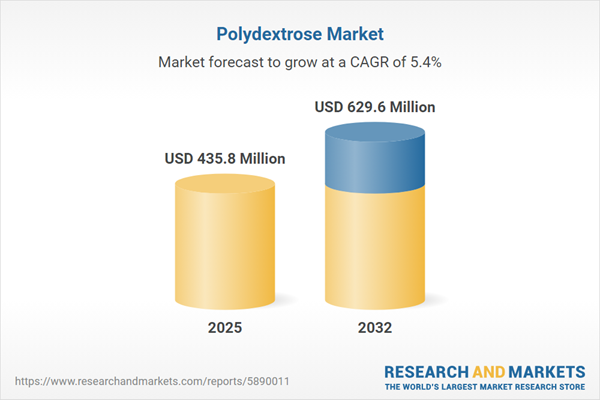Speak directly to the analyst to clarify any post sales queries you may have.
The polydextrose market is experiencing rapid evolution as regulatory shifts, advancements in processing technologies, and changes in global supply chains drive new strategies among industry leaders. Senior executives are increasingly focusing on anticipating market movements, strengthening compliance, and leveraging innovation to secure growth and resilience.
Market Snapshot: Polydextrose Market Size and Growth
The global polydextrose market is on an upward trajectory, led by expanding demand from manufacturers looking for innovative, regulation-compliant ingredients. Market research indicates strong growth, with the polydextrose sector forecasted to rise from USD 413.19 million in 2024 to USD 435.80 million in 2025, ultimately reaching USD 629.60 million by 2032, reflecting a projected CAGR of 5.40%. This momentum is shaped by integration across food, beverage, nutraceutical, and wellness sectors, responding directly to consumer preferences for healthier options and more rigorous nutrition standards. Polydextrose is increasingly embedded both in cornerstone brands and next-generation wellness offerings, serving as a catalyst for product development and market expansion.
Scope & Segmentation of the Global Polydextrose Market
- Application: Animal feed manufacturers incorporate polydextrose to enhance nutritional content in cattle, poultry, and swine feeds; food producers utilize it in baked goods, dairy products, beverages, desserts, and confectionery; pharmaceutical and nutraceutical organizations use polydextrose to improve bioavailability in formulation development.
- Function: Polydextrose supplies bulk, raises dietary fiber, acts as a low-calorie sweetener, and delivers prebiotic effects—addressing core demands for nutrition reformulation and enabling the creation of health-oriented products.
- Product Type: Available as granules, powder, and liquid, polydextrose allows for adaptable processing routes and supports both established and emerging product development pipelines.
- Form: Distributed in solid and liquid variants, providing manufacturers with options to streamline procurement and production, whether for broad-market or specialty product targets.
- Distribution Channel: Widely distributed via convenience stores, online platforms, pharmacies, supermarkets, hypermarkets, and specialist retailers, ensuring access for a spectrum of industry participants and end-use sectors.
- Geographic Coverage: Present in the Americas, Europe, Middle East & Africa, and Asia-Pacific regions, with notable activity in the United States, Germany, India, Brazil, China, and Australia—each navigating distinct regulatory and operational challenges.
- Featured Companies: Key market participants include Ingredion Incorporated, Archer Daniels Midland Company, International Flavors & Fragrances Inc., Tate & Lyle PLC, Roquette Frères SA, Matsutani Chemical Industry Co., Ltd., Daicel Corporation, Shandong Bailong Chuangyuan Bio-Tech Co., Ltd., and Qingdao Dongxin Chemical Co., Ltd., recognized for consistent supply and commitment to product innovation.
Polydextrose Market: Key Takeaways for Senior Decision-Makers
- Polydextrose enables manufacturers to reformulate products with lower sugar content and calorie density, aligning portfolios with growing wellness and nutrition trends.
- Transparent labeling and adaptability for credible health claims position polydextrose as a suitable solution for clean-label priorities and dynamic regulatory standards.
- Technical advancements, such as enzymatic synthesis and microencapsulation, are broadening the scope of applications in functional and premium food segments, supporting greater market differentiation.
- Enhanced compliance processes are facilitating smoother multinational operations and more efficient cross-border risk management in an increasingly uncertain regulatory environment.
- Emphasis on supply chain resilience—through vertical integration, diversification of suppliers, and logistics optimization—ensures product continuity during periods of global market disruption.
- The development of customized polydextrose blends is enabling market participants to access emerging niche categories and establish competitive advantages within evolving demand segments.
Tariff Impact on Supply Chains and Adaptation Strategies
Adjustments in U.S. tariff policy have prompted both suppliers and buyers within the polydextrose sector to re-examine procurement and supply frameworks. Common organizational responses now include diversifying the supplier base, implementing nearshoring solutions, and upgrading inventory management practices to reduce exposure to volatile conditions. Parallel investments in process engineering and product reformulation support compliance and operational flexibility amid an evolving trade environment.
Methodology & Data Sources
This market analysis leverages insights from expert interviews, regulatory review, peer-reviewed literature, and scenario-based modeling. The mixed-methods approach ensures every insight is practical and actionable for senior leaders defining strategic priorities or investment roadmaps.
Why This Report Matters
- Equips senior decision-makers to refine research, production, and distribution planning in a dynamically evolving polydextrose landscape.
- Delivers actionable perspectives on supply dynamics, regulatory shifts, and distribution channels to enhance risk management and operational resilience.
- Facilitates clear benchmarking for investment and partnership decisions—supporting optimized resource allocation as market transformation continues.
Conclusion
Sustained growth in the polydextrose market is driven by technology adoption and robust compliance strategies. Flexible supply chains and innovative sourcing practices ensure that value is maintained even as industry conditions continue to evolve.
Additional Product Information:
- Purchase of this report includes 1 year online access with quarterly updates.
- This report can be updated on request. Please contact our Customer Experience team using the Ask a Question widget on our website.
Table of Contents
3. Executive Summary
4. Market Overview
7. Cumulative Impact of Artificial Intelligence 2025
Companies Mentioned
The companies profiled in this Polydextrose market report include:- Ingredion Incorporated
- Archer Daniels Midland Company
- International Flavors & Fragrances Inc.
- Tate & Lyle PLC
- Roquette Frères SA
- Matsutani Chemical Industry Co., Ltd.
- Daicel Corporation
- Shandong Bailong Chuangyuan Bio-Tech Co., Ltd.
- Qingdao Dongxin Chemical Co., Ltd.
Table Information
| Report Attribute | Details |
|---|---|
| No. of Pages | 184 |
| Published | October 2025 |
| Forecast Period | 2025 - 2032 |
| Estimated Market Value ( USD | $ 435.8 Million |
| Forecasted Market Value ( USD | $ 629.6 Million |
| Compound Annual Growth Rate | 5.4% |
| Regions Covered | Global |
| No. of Companies Mentioned | 10 |









